2003 PONTIAC BONNEVILLE wheel size
[x] Cancel search: wheel sizePage 327 of 418
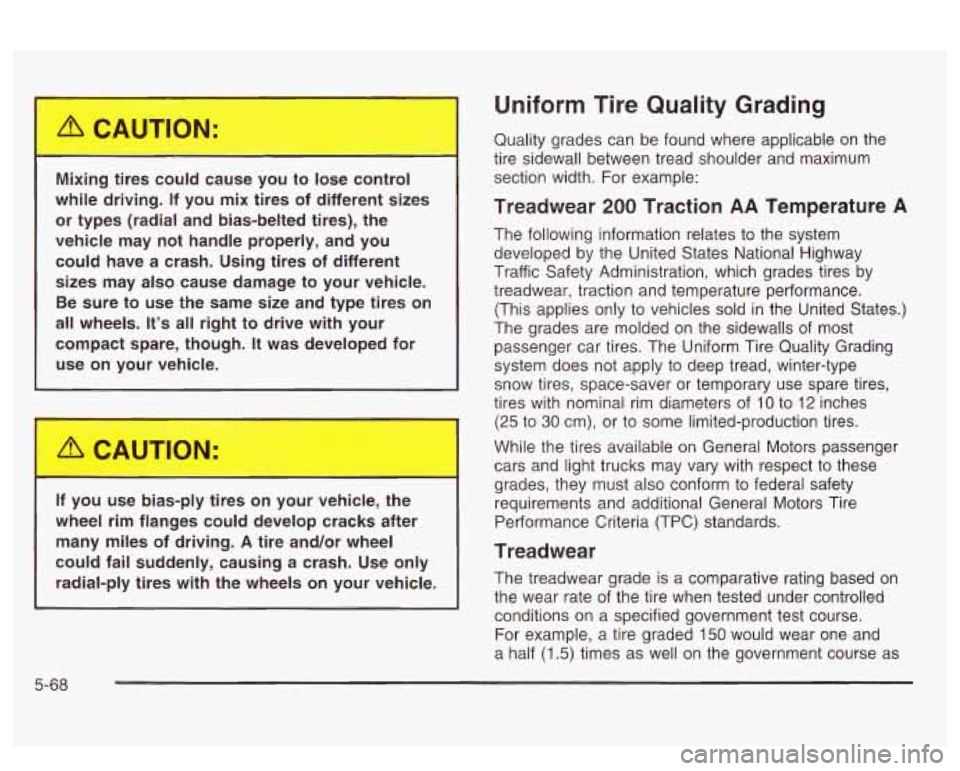
Mixing tires couh :ause you to lose control
while driving. If you mix tires of different sizes
or types (radial and bias-belted tires), the
vehicle may not handle properly, and you
could have a crash. Using tires of different
sizes may also cause damage to your vehicle.
Be sure to use the same size and type tires on
all wheels. It’s all right to drive with your
compact spare, though.
It was developed for
use on your vehicle.
I
If you use bias-ply tires on your vehicle, the
wheel rim flanges could develop cracks after many miles of driving.
A tire and/or wheel
could fail suddenly, causing a crash. Use only
radial-ply tires with the wheels on your vehicle.
5-68
Uniform Tire Quality Grading
Quality grades can be found where applicable on the
tire sidewall between tread shoulder and maximum
section width. For example:
Treadwear 200 Traction AA Temperature A
The following information relates to the system
developed by the United States National Highway
Traffic Safety Administration, which grades tires by
treadwear, traction and temperature performance.
(This applies only
to vehicles sold in the United States.)
The grades are molded on the sidewalls of most
passenger car tires. The Uniform Tire Quality Grading
system does not apply to deep tread, winter-type
snow tires, space-saver or temporary use spare tires,
tires with nominal rim diameters
of 10 to 12 inches
(25
to 30 cm), or to some limited-production tires.
While the tires available on General Motors passenger
cars and light trucks may vary with respect to these
grades, they must also conform
to federal safety
requirements and additional General Motors Tire
Performance Criteria (TPC) standards.
Treadwear
The treadwear grade is a comparative rating based on
the wear rate of the tire when tested under controlled
conditions on a specified government test course.
For example, a tire graded 150 would wear one and
a half (1.5) times as well on the government course as
Page 330 of 418
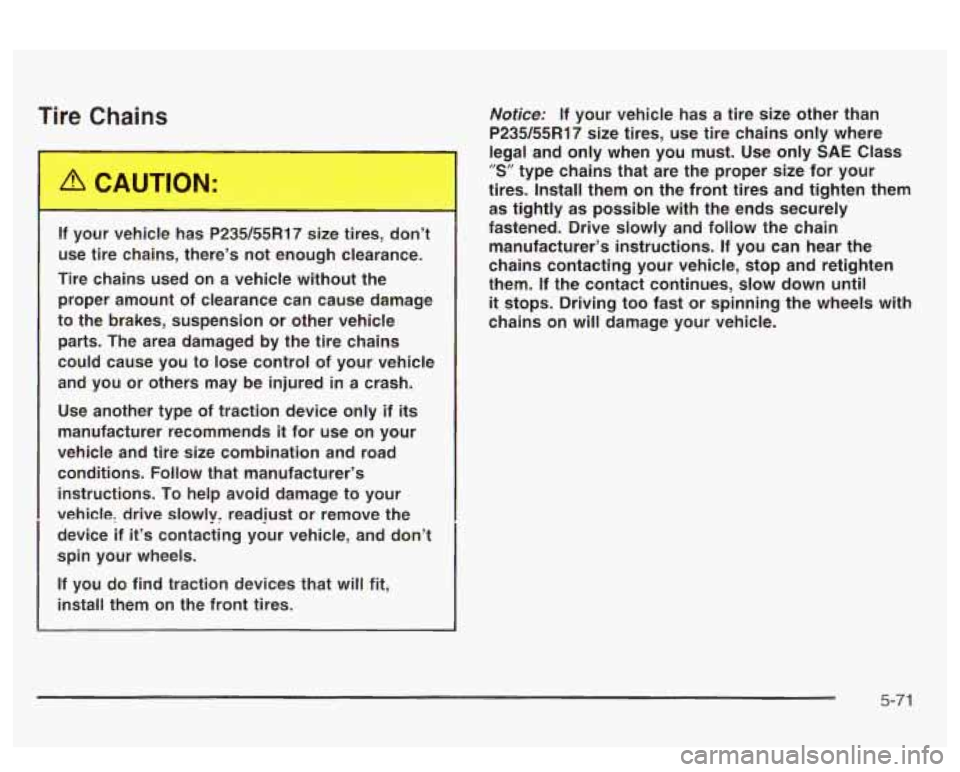
Tire Chains
If your vehicle has P235/55R17 size tires, don’t
use tire chains, there’s not enough clearance.
Tire chains used on a vehicle without the proper amount of clearance can cause damage
to the brakes, suspension or other vehicle
parts. The area damaged by the tire chains
could cause you
to lose control of your vehicle
and you or others may be injured in a crash.
Use another type of traction device only if
its
manufacturer recommends it for use on your
vehicle and tire size combination and road
conditions.
Follow that manufacturer’s
instructions.
To help avoid damage to your
vehicle, drive slowly, readjust or remove the
device if it’s contacting your vehicle, and don’t
spin your wheels.
If you do find traction devices that will
fit,
install them on the front tires.
Notice: If your vehicle has a tire size other than
P235/55R17 size tires, use tire chains only where
legal and only when you must. Use only
SAE Class
”S” type chains that are the proper size for your
tires. Install them on the front tires and tighten them as tightly as possible with the ends securely
fastened. Drive slowiy and follow the chain manufacturer’s instructions. If you can hear the
chains contacting your vehicle, stop and retighten
them. If the contact continues,
slow down until
it stops. Driving too fast or spinning the wheels with
chains on will damage your vehicle.
5-7 1
Page 338 of 418
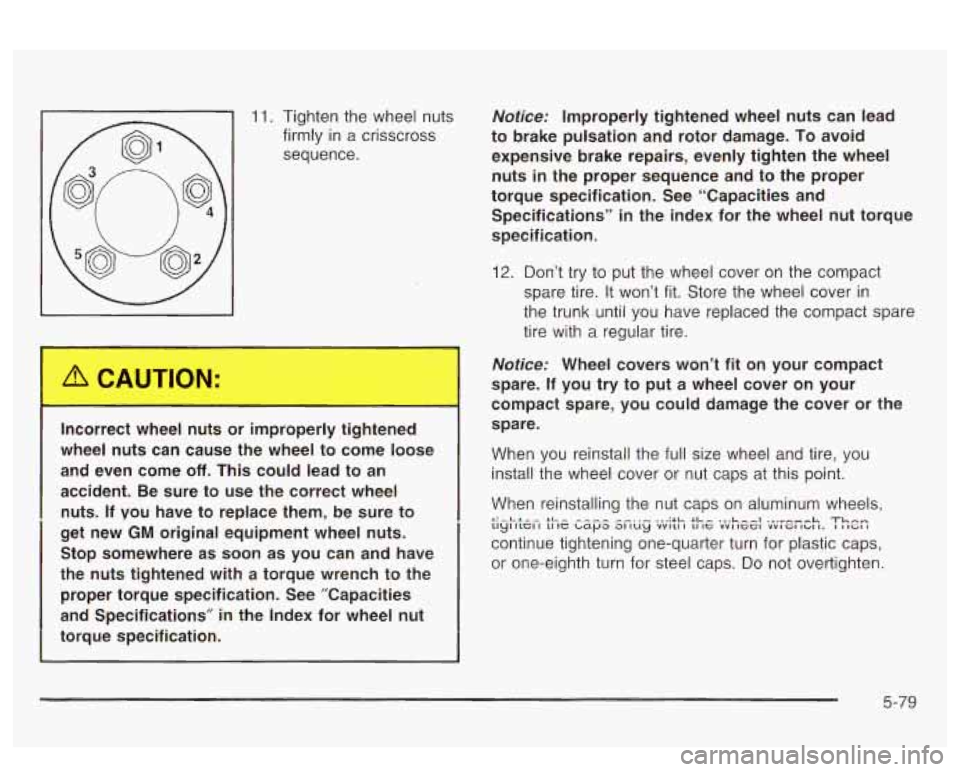
11. Tighten the wheel nuts
firmly in a crisscross
sequence.
Incorrect wheel nuts or improperly tightened
wheel nuts can cause the wheel to come loose
accident. Be sure to use the correct wheel
nuts. If you have to replace them, be sure to
get new
GM original equipment wheel nuts.
Stop somewhere as
soon as you can and have
the nuts tightened with a torque wrench to
the
proper torque specification. See ”Capacities
and Specifications”
in the Index for wheel nut
torque specification.
~ and even come off. This could lead to an
Notice: Improperly tightened wheel nuts can lead
to brake pulsation and rotor damage.
To avoid
expensive brake repairs, evenly tighten the wheel
nuts
in the proper sequence and to the proper
torque specification. See “Capacities and
Specifications”
in the index for the wheel nut torque
specification.
12. Don’t try to put the wheel cover on the compact
spare tire. It won’t fit. Store the wheel cover in
the trunk until you have replaced the compact spare
tire with a regular tire.
Notice: Wheel covers won’t fit on your compact
spare. If you try to put a wheel cover on your
compact spare, you could damage the cover or the
spare.
When you reinstall the full size wheel and tire, you
install the wheel cover or nut caps at this point.
When reinstalling the nut caps on aluminum wheels,
continue tightening one-quarter turn for plastic caps,
or one-eighth turn for steel caps.
Do not overtighten.
*:-.LA-.- AI-- --_- -_..- ..,:&I- &L- ..,L--l .-,v-mah llylllell tile Lapa a11uy vvlu I 11 IG VVIIGGI VVIGII’CIII. I IIGI I
5-79
Page 339 of 418
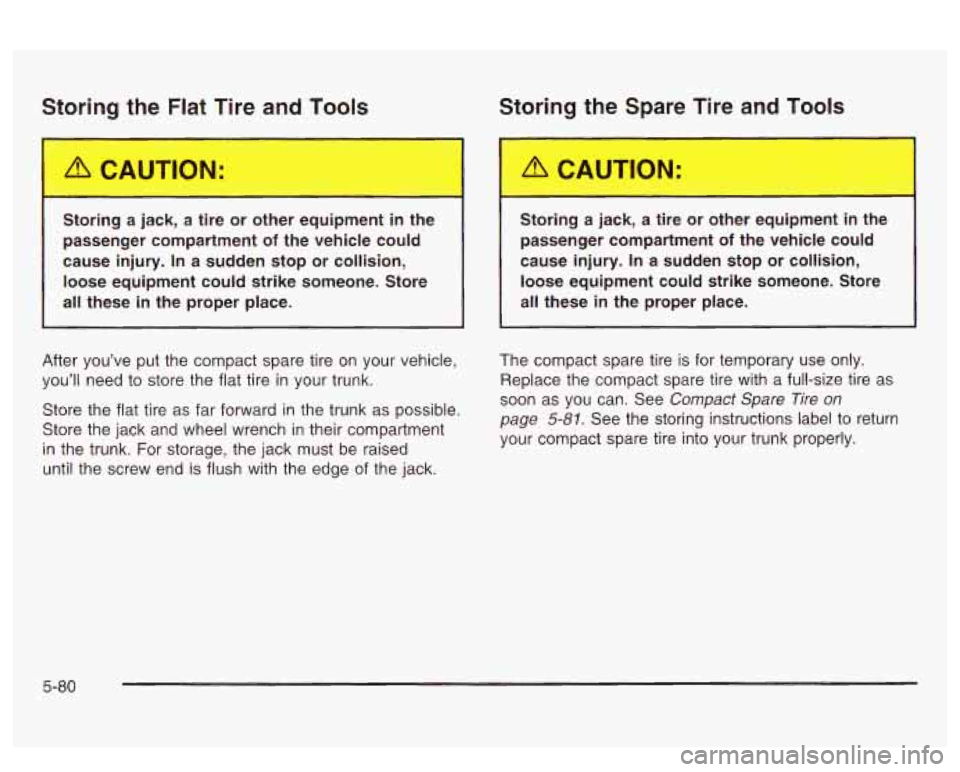
C+oring the Flat Tire -nd Tvls
Storing ‘he S-nre T:-e and Tc-Is
I.--=-
Storing a jack, a tire or other equipment in the
passenger compartment
of the vehicle could
cause injury. In a sudden stop or collision, loose equipment could strike someone. Store
all these
in the proper place.
After you’ve put the compact spare tire on your vehicle,
you’ll need to store the flat tire in your trunk.
Store the flat tire as far forward in the trunk as possible.
Store the jack and wheel wrench in their compartment
in the trunk. For storage, the jack must be raised
until the screw end is flush with the edge of the jack. ,tor
J a.
:k, a tire or other equipment in the
passenger compartment
of the vehicle could
cause injury. In a sudden stop or collision, loose equipment could strike someone. Store
all these in the proper place.
The compact spare tire is for temporary use only.
Replace the compact spare tire with
a full-size tire as
soon as you can. See
Compact Spare Tire on
page 5-87. See the storing instructions label to return
your compact spare tire into your trunk properly.
5-80
Page 340 of 418
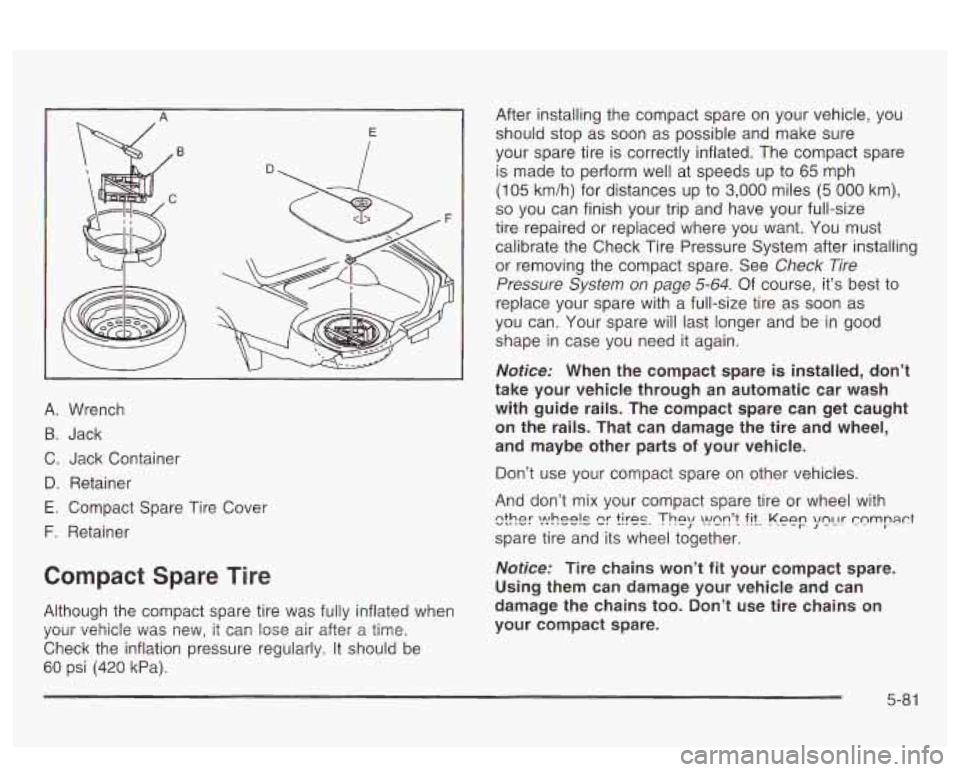
/
.B
C
I
I E
I I
A. Wrench
B. Jack
C. Jack Container
D. Retainer
E. Compact Spare Tire Cover
F. Retainer
Compact Spare Tire
Although the compact spare tire was fully inflated when
Check the inflation pressure regularly. It should be
60 psi (420 kPa).
..^..I yuul vehicle was iievi, it mi7 lose air after a tine. After
installing the compact spare on your vehicle, you
should stop as soon as possible and make sure
your spare tire is correctly inflated. The compact spare
is made to perform well at speeds up to 65 mph
(105 km/h) for distances up to 3,000 miles (5 000 km)~
so you can finish your trip and have your full-size
tire repaired or replaced where you want. You must:
calibrate the Check Tire Pressure System after installing
or removing the compact spare. See
Check Tire
Pressure
System on page 5-64. Of course, it’s best to
replace your spare with a full-size tire as soon as
you can. Your spare will last longer and be in good
shape in case you need
it again.
Notice: When the compact spare is installed, don’t
take your vehic!e through
an automatic car wash
with guide rails. The compact spare can get caught on the rails. That can damage the tire and wheel,
and maybe other parts
of your vehicle.
Don’t use your compact spare on other vehicles.
And don’t mix your compact spare tire or wheel with
spare tire and its wheel together.
ether t!!hee!s ?irks. The;/ w~n’t fit. Kppp yncIr Cnmrpct
Nofice: Tire chains won’t fit your compact spare.
Using them can damage your vehicle and can
damage the chains too. Don’t use tire chains on
your compact spare.
5-81